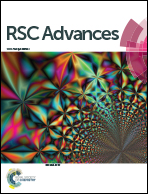New insights into catalytic pyrolysis mechanisms and reaction pathways of urea pyrolysis on V–Ti catalyst surfaces†
Abstract
A series of V–Ti catalysts with different vanadium loadings for urea pyrolysis were synthesized using the impregnation method and showed desirable catalytic activity. The results showed that the catalysts could accelerate the pyrolysis of urea and inhibit the formation of byproducts. The urea conversion over the catalysts was in the order of 1% V–Ti > 0.5% V–Ti ≈ TiO2 > 5% V–Ti > 10% V–Ti > pure urea, which was associated with the total acidity of the catalysts. The identification and quantification of major byproducts, e.g. biuret, cyanuric acid and melamine, were conducted by HPLC and FT-IR between 100 °C and 450 °C. The reaction pathways of urea pyrolysis in the presence of 1% V–Ti catalysts were proposed based on the byproduct distributions. In the presence of the catalysts, urea pyrolysis was accelerated with a lower initial decomposition temperature. Moreover, the catalysts could promote the further conversion of major byproducts, biuret and cyanuric acid, to the final products NH3 and HNCO at lower temperatures compared to the cases without catalysts.


 Please wait while we load your content...
Please wait while we load your content...